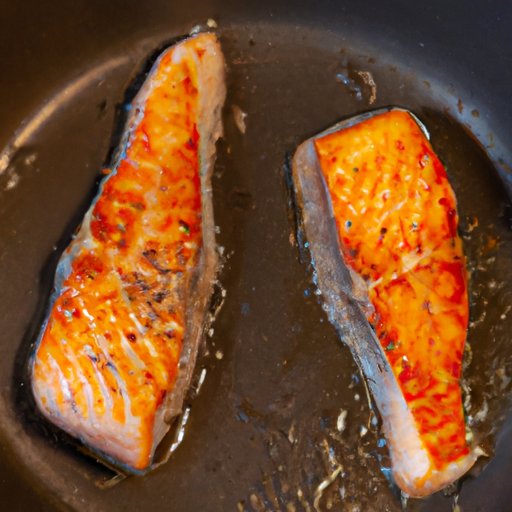
I. Introduction
If you’re a fan of seafood, chances are you’ve heard of salmon. This delicious fish is not only incredibly nutritious, but it’s also incredibly versatile, making it a popular dish any time of the day. Pan-cooked salmon has become a household favorite, with its crispy texture on the outside and tender juiciness on the inside. Knowing how to cook it perfectly is essential to make any dish that involves salmon enjoyable. This article covers everything you need to know about cooking salmon in a pan, including pro-tips and easy-to-follow recipes, making seafood cooking accessible to beginners and pros alike.
II. A Step-by-Step Guide to Perfectly Pan-Seared Salmon for Beginners
Beginners may feel a bit intimidated by cooking salmon in a pan, but it’s easier than you think. Here are essential steps to keep your salmon dish from turning out fishy and flavorless:
1. Season your salmon fillet with salt and pepper or any other spices you fancy.
2. Preheat your non-stick pan with oil over medium-high heat. When the pan gets hot enough, carefully place the salmon skin-side down, using a spatula to press it gently for an even cook. Leave it alone for about 3-5 minutes until the skin crisps up.
3. Flip to the non-skin side of the salmon to cook for another 2-4 minutes, depending on the thickness of the fillet.
4. Lastly, remove the pan from the heat and let the salmon rest for a minute or two. It will continue to cook on its residual heat, reaching the appropriate cooking temperature of 145F.
Remember, the longer you cook the fish, the drier it gets; it’s okay to have a little pink in the middle, trust us on this one.
III. Top Tips for Making Deliciously Sautéed Salmon at Home
Sautéeing salmon is another great way to achieve flavorful and juicy fish that’s perfect for salads and sandwiches. Here are a few critical tips and tricks to keep in mind:
1. Again, seasoning your salmon with salt and pepper before cooking is essential.
2. Preheat your pan before adding oil or clarified butter to it. You want the pan to be hot before placing the salmon in it to prevent it from sticking to the pan.
3. To achieve a flavorful sauce, cook aromatics such as garlic or sliced onions in the same pan after cooking the salmon. You can use white wine or lemon juice to deglaze the pan and make the sauce.
4. Cook salmon for about 4-6 minutes for every one-inch thickness.
IV. 5 Easy Recipes to Make with Pan-Fried Salmon
Pan-cooked salmon is undoubtedly tasty, but what about making something new with it? Here are some impressive recipes to try:
1. Salmon Pasta Salad: Cook salmon and toss with cooked pasta, cherry tomatoes, and grated Parmesan cheese in a creamy pesto sauce, and voila!
2. Salmon Poke Bowl: Mix salmon, avocado, soy sauce, and seaweed to create an excellent poke bowl dish that’s perfect for a quick and hearty lunch.
3. Salmon Soup: Combine cooked salmon with potatoes, carrots, and celery in a vegetable broth for a satisfying dinner any day of the week.
4. Salmon Curry: Add salmon cubes to a creamy coconut sauce, and serve with freshly cooked rice.
5. Salmon Tacos: Fry pieces of salmon until golden and add to flour or corn tortillas with shredded cabbage and a squeeze of lime for a quick meal that�s perfect for any Mexican food lover.
V. A Low-Carb Guide to Pan-Fried Salmon
If you’re on a low-carb diet, you can still savor the goodness of salmon without ruining your diet. Here are some tips and tricks to try:
1. Use non-carb flour options like almond or coconut flour to baste salmon. Dip the flour-coated salmon in beaten eggs and cook in the pan for a delicious, crispy crust.
2. Bake your salmon instead of frying for a low-carb alternative.
3. Serve with low-carb options like roasted broccoli, asparagus, or salad greens for a perfect low-carb serving.
VI. Mastering the Art of Cooking Salmon in a Pan
If you’re looking to take your salmon-cooking skills to the next level, you might be interested in these creative ideas:
1. Pick a salmon cut that’s perfect for the recipe; for instance, Coho salmon is perfect for grilling, while Sockeye salmon works better for smoking or curing.
2. As a step up from just seasoning with salt and pepper, try marinading your salmon in herbs or spices to infuse more flavors into your dish.
3. Serve your salmon in different ways, such as in a stir-fry or taco, to add an extra twist to traditional salmon dishes.
VII. Steps to the Perfectly Pan-Cooked Crispy Salmon
A crispy crust is an excellent addition to your pan-cooked salmon. Here are the steps to achieving that perfect crispy salmon:
1. Prepare your salmon with a coating of cornmeal before placing it in the pan. Cornmeal works as a natural breading that creates a crisp outer layer while keeping the inside moist.
2. Allow the pan to heat adequately before cooking the salmon. A hot pan ensures a crispy crust while a cold one leads to a soggy outer layer.
3. Use clarified butter instead of regular oil – clarified butter burns at a higher temperature than regular fat, making it better suited for pan-cooking salmon at high temperatures.
VIII. Conclusion
There you have it, folks – a comprehensive guide to cooking salmon in a pan. Whether you’re a seasoned cook or a beginner, we hope you’ve found some useful tips and learned some new techniques to improve your salmon-cooking game. Remember, be patient and adventurous – this delicious fish is perfect for experimenting with different flavors and seasonings, making it a dish that you’ll never get bored of cooking.





